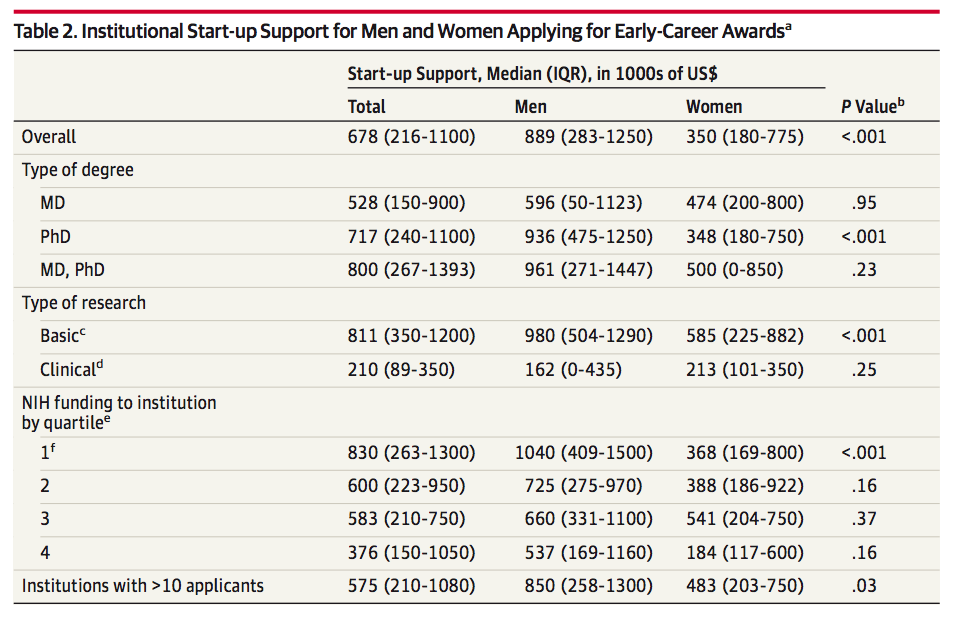Females in Basic Sciences Get Seriously Screwed in Startup Packages. Knowledge is Power, So Plan Your Ask Accordingly.
Warning: This blog may cause your head to explode. Please put on protective gear to ensure cortical matter does not damage university instrumentation.
One of the hardest parts of applying for jobs is entering the black hole known as ‘negotiations.’ You know, the equipment, personnel and resources you need to successfully to launch your lab. But all of a sudden you are looking at a spreadsheet with a lot of zeros and it’s easy to wonder if you will or even can get what you need to succeed. This anxiety is particularly acute in women doing basic science research who have been shown to get far less startup money compared to their male peers.
A 2015 JAMA study compared women and men in biomedical research with breakdowns between MDs, PhDs, MD/PhDs and basic and clinical researchers. Data was collected from applications submitted to two regional junior investigator programs from 2012-2014. The results showed women women working in the basic sciences got a staggering 61% less startup money than male colleagues. This trend was seen across institutions and was actually worse at institutions that had more grant support. 
This huge disparity is something many women had long suspected existed, but discussion of how much was in your startup packages was largely considered verboten. My startup package was less than $350K and when I included ‘big asks’ for live cell imaging microscopy, two years of a technician and vouchers for animal cores, I was denied. It wasn’t that I couldn’t have ACCESS to those instruments, it’s just that I couldn’t HAVE the instruments. Flash forward three years later. Two men are recruited and they got double my startup package, a $25K bonus for moving (I had to move too!) and 20% more salary than what I was earning.
What are you going to do? Go ask for more? I wasn’t. In my opinion, I was given what the institution felt I was worth. I got an R01 right away but in the recession, when my grants got slashed by 23% and I gapped, I had to depend on my institution to support me. It felt like hell. I felt like hell. To this day, I’m constantly anxious about growing my lab “too big” even in times where we have reasonable funding and I could afford to bring on more people.
Learn from my mistakes and the information on gender gaps from JAMA.
- Don’t let anyone make your start up package personal. Negotiating is about your work and what you need. In my negotiations, I was implored (by someone who is no longer my boss) to ‘be a team player.’ I was told my needs were just part of an entire recruitment package they were overseeing to bring in several young PIs. I wish I had answered that having six underfunded investigators was a far worse strategy than having four fully funded PIs.
- Move fast and furious. Negotiations will wear you down, and the longer you are going back and forth the more willing you are to relent. Do your business quickly and effectively and get your offer letter signed.
- Find allies. If you are trying to get a new piece of equipment, be able to cite some folks within the department or center who could be potential collaborators and benefit from investing in the equipment you need.
- Talk to someone who has just moved. These folks will be a wealth of information about unanticipated costs associated with moving you should be getting reimbursed or covered.
- Don’t forget your service contracts. Major equipment comes with major price tags when something goes wrong. Be sure you know your local sales and service reps and that they can cover a range of potential disasters.
Do you have other negotiating protips on startup packages? Feel like you got the short end of the stick and wish you had this JAMA data earlier? We have a Comments section just for you! Good luck and happy sciencing!







1 Comment
A 2015 JAMA study compared women and men in biomedical research with breakdowns between MDs, PhDs, MD/PhDs and basic and clinical researchers. Data was collected from applications submitted to two regional junior investigator programs from 2012-2014.
Where were your data collected? How large sample size? What are junior investigator programs? Is this from Carnegie I Research Intensive Universities?